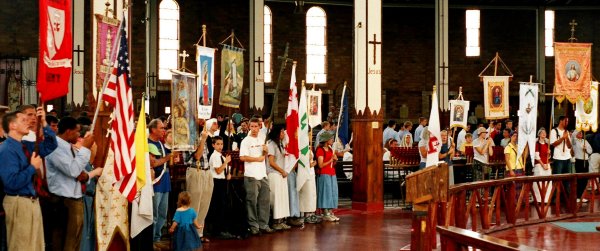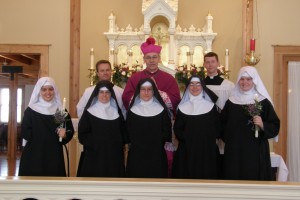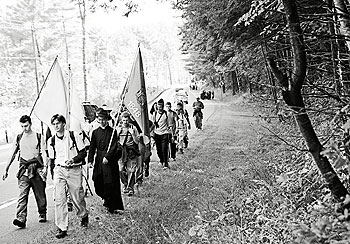It’s 11pm in Rome, and the first ballot shows Read More
Category: The Saints
Blood of Martyrs, Seed of the Church in North America, too
by Farley Clinton
During the second part of the nineteenth century, the bishops of the United States were perhaps more zealous, more persistent, more successful in promoting the canonization of the French Jesuit martyrs of North America than they would ever be in working for any other American canonization.
They encouraged devout Catholics to make pilgrimages to sites associated with these martyrs, and the laity in fairly large numbers did make such pilgrimages — and often reported striking answers to their prayers of petition.
One French nun, recently beatified by Venerable John Paul II, may well have played an important role in spreading the fame of the martyr Jean de Brebeuf, SJ. This was the Blessed Catherine of Saint Augustine. She was reportedly said by the first Bishop of Quebec — the Blessed Francois de Montmorency Laval — to be the holiest person in the whole diocese. Supposedly, he added that miracles confirmed his opinion of her great sanctity, though he had had no need of those miracles to feel sure of it.
Blessed Catherine had visions of Saint Jean de Brebeuf, in which the holy martyr assured her that God would make use of him to confer great blessings and benefits on “Canada,” which would seem likely to mean North American a general way, rather than the political unit, the modern nation, that later came into existence, which bears now the name. It was then still the colony built up by French Catholics, who labored seriously to evangelize the native peoples whom they met, but eventually were themselves defeated and conquered by English Protestants in 1763 — and, 13 years after that (in 1776) did not rebel against English rule in the fashion of the strongly Protestant colonies that had been founded by the English in the 17th century.
The priest Isaac Jogues and the two who were not priests, Goupil and de Lalande, died in what later became the state of New York in the USA, and on this account attracted special veneration there. Everywhere else St. Jean de Brebeuf seems always to have treated as the outstanding figure among all these martyrs. He had a great many visions and apparitions, and none of the other martyrs seems to have resembled him in this point.
In one of his visions, he saw a Jesuit who was slowly but horribly turned into a demon. Until the last sixty years and the wide circulation of Teilhard de Chardin’s writing denying the existence of God and specially calling for a revolt against the whole traditional understanding of many virtues, such as chastity, detachment, and resignation, no one seems to have professed to know what Saint Jean de Brebeuf’s vision of a devil-priest might predict.
Among the French in Quebec, it appears that the one great miracle-worker was Catherine Tekakwitha, while the Jesuit martyrs hardly had any comparable fame. Eventually, in 1925 the efforts of the United States bishops achieved the beatification of the eight Jesuit martyrs — helped by strong prodding from Pius XI. And it seems that no miracle was recognized as justifying their public veneration — nor was thought necessary, in view of their unquestioned fame as great martyrs. After their beatification two miracles — both cures of nuns evidently — were accepted by the Holy See to authorize their canonization in 1930. TIME — the Luce magazine — published a small article about them. Both took place in Canada.
To be continued.
Among innumerable works of mercy in a long-life of inestimably kind contributions to the Church’s new evangelization, Farley Clinton is an advisor to the 30+ year-old apostolate, NCCL.




 Send them packing … on a traditional, walking pilgrimage.
Send them packing … on a traditional, walking pilgrimage. Brigade banners at final Mass, Pilgrimage 2010
Brigade banners at final Mass, Pilgrimage 2010 Both Priests flanking His Excellency, Bishop Finn of Kansas City – St. Joseph, have made the Pilgrimage for Restoration as clerics. Two of the young Nuns made the Pilgrimage before taking the Veil.
Both Priests flanking His Excellency, Bishop Finn of Kansas City – St. Joseph, have made the Pilgrimage for Restoration as clerics. Two of the young Nuns made the Pilgrimage before taking the Veil.